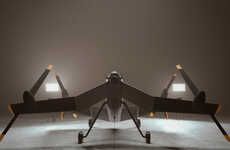The Flying Machine Arena Team led by Raffaello D’Andrea of the Swiss Federal Institute of Technology have invented flying robots capable of assembling architecture.
Each robot is equipped with four copters that allow it to glide through the air almost like magic. A computer program known as The Foreman tells the flying robots where to place the bricks. Once the flying robot has its instructions, it picks up bricks one by one and places them where it’s told. A demonstration of these flying robots was held in France, where the robots built a wall in front of a live audience. These flying robots may change the architecture and design industry forever. The possibilities these robots present opens the doors to creativity and allows designers more freedom in their thinking. It may not be long before construction workers are replaced by these inventions presented by the Flying Machine Arena Team.
Robot-Built Installations
The Flying Machine Arena Team Presents Clever Droids
Trend Themes
1. Flying Robotics - The use of self-navigating flying robots for construction and installation purposes is a disruptive innovation that presents new possibilities and efficiency in the architecture and building industry.
2. Automated Construction - The use of The Foreman computer program to guide robotic drones in assembling architecture represents a major innovation in the construction industry and introduces the potentiality for autonomous and seamless building construction.
3. Artificial Intelligence for Architecture - The potential widespread implementation of advanced algorithms and machine learning software in construction and design processes may lead to greater advances in architectural design and practical building techniques.
Industry Implications
1. Architecture - The use of flying robots and artificial intelligence in architecture opens up the possibility for creating and designing buildings that might not have been possible before while also introducing new ways of assembly and installation.
2. Construction - The development of self-navigating robots for building and construction purposes has the potential to revolutionize the industry by streamlining construction processes, reducing labor costs, and increasing safety standards.
3. Design - The use of computer-guided robots for assembling architecture provides designers and engineers with a wider array of possibilities to explore while building high-quality, safe, and affordable structures, which may lead to greater creative experimentation and innovation.




